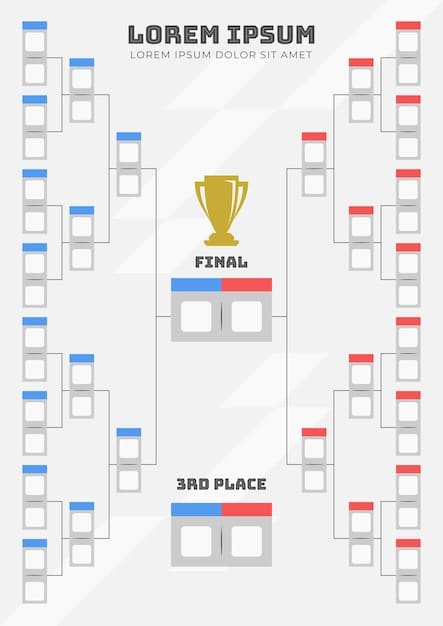Champions League Draw: Analyzing Group Stage Paths for US Fans

Champions League Group Stage Draw: Analyzing the Easiest and Hardest Paths for US-Supported Teams involves examining the potential routes for teams popular in the United States through the Champions League group stage, considering factors like opponent strength, travel distance, and historical performance to determine the most and least favorable scenarios.
The Champions League group stage draw is always a highly anticipated event, but for fans in the US, it carries extra significance. How will the draw affect the chances of teams with strong American support? Let’s analyze the easiest and hardest paths for US-supported teams through the Champions League Group Stage Draw: Analyzing the Easiest and Hardest Paths for US-Supported Teams this season.
Understanding the Champions League Group Stage Draw
The Champions League group stage draw sets the stage for the tournament, determining who faces whom in the initial phase. The draw is governed by specific rules and seeding systems to ensure a balanced and competitive landscape. Understanding these rules is crucial for assessing the potential paths for any team.
Seeding and Pots
Teams are divided into four pots based on their UEFA club coefficients, which reflect their performance in European competitions over the past five seasons. Pot 1 typically includes the Champions League and Europa League winners, along with the champions of the top six European leagues. The remaining pots are populated by teams with decreasing coefficients.
Draw Restrictions
The primary restriction is that teams from the same country cannot be drawn into the same group. Additionally, to create a balanced schedule, UEFA also tries to separate teams from the same association as much as possible across the groups.
- Geographical Considerations: Teams from the same country are kept apart.
- Coefficient Ranking: Higher-ranked teams are seeded to avoid early clashes.
- Broadcast Considerations: UEFA considers TV audiences when scheduling matches.
Understanding these factors helps to analyze the draw effectively. The seeding ensures top teams are spread out, while restrictions add complexity to predicting outcomes.

The Champions League group stage draw is more than just a random selection; it’s a carefully orchestrated event that shapes the landscape of the competition.
Teams with Strong US Support: A Quick Overview
Several European teams boast significant fan bases in the United States. This support comes from a variety of factors, including historical success, star players, and marketing efforts targeted at the American market. Identifying these teams is essential for understanding who US fans will be rooting for.
Premier League Giants
Teams like Manchester United, Liverpool, and Chelsea have large American fan bases due to their consistent success and global appeal. These clubs frequently tour the US for pre-season friendlies, further solidifying their presence in the American soccer landscape.
La Liga Powerhouses
Barcelona and Real Madrid also enjoy widespread support in the US. Their rich history and the presence of iconic players have made them household names among American soccer fans.
Other Notable Mentions
Bayern Munich, Paris Saint-Germain, and Juventus also have growing fan bases in the US, driven by their domestic dominance and participation in major European competitions.
These teams, with their substantial US support, are the ones to watch closely during the Champions League draw. Their paths through the group stage will be of great interest to American fans.
Analyzing the “Easiest” Possible Draw
Determining the “easiest” draw is subjective, but generally, it involves avoiding the strongest teams from each pot. A favorable draw allows a team to progress to the knockout stages with relative ease, conserving energy and avoiding early injuries.
Pot 1: Avoiding the Giants
While Pot 1 teams are all strong, some are arguably more manageable than others. Avoiding teams like Manchester City or Bayern Munich would be a positive start.
Pots 3 and 4: Identifying Weaker Opponents
Pots 3 and 4 often contain teams that are either newly qualified or have lower UEFA coefficients. Drawing these teams can significantly increase a team’s chances of advancing.
- Historical Performance: Look for teams with a poor track record in the Champions League.
- Current Form: Consider teams that are struggling in their domestic leagues.
- Financial Resources: Teams with limited financial resources may lack squad depth.
An easy draw might include a Pot 3 team from a smaller league and a Pot 4 team that is making its debut in the competition. These matchups offer the best chance for racking up points.
An “easiest” draw is a blend of strategic advantages, avoiding major powerhouses, and capitalizing on matchups that offer a clear pathway to the knockout stages.
Assessing the “Hardest” Possible Draw
The “hardest” draw involves facing a gauntlet of top teams from each pot, creating a challenging and potentially exhausting group stage campaign. Such a draw can jeopardize a team’s chances of advancing and impact their performance in other competitions.
Pot 1: Drawing the Reigning Champions
Facing the reigning Champions League winner or a team with a history of dominance in Europe is always a daunting prospect. These teams often have the experience and quality to make life difficult for any opponent.
Pots 2, 3, and 4: Facing Strong Contenders
A difficult draw could include a Pot 2 team like Real Madrid, a Pot 3 team with a strong recent record in Europe, and a Pot 4 team that is a dark horse in the competition.
Key indicators of a challenging draw include:
- Multiple Title Winners: A group with several teams who have won the Champions League.
- Tactical Complexity: Teams known for their strategic prowess and ability to adapt.
- Physical Demands: Opponents with a high-pressing style that requires intense physical effort.
A “hardest” draw is a combination of historical giants, tactical masterminds, and physically demanding opponents, creating a path fraught with challenges and uncertainties.
Potential Impacts on US Viewership and Betting
The Champions League draw significantly impacts US viewership and betting patterns. Favorable draws for teams with strong US support can lead to increased interest and engagement, while difficult draws can dampen enthusiasm.
TV Ratings and Streaming Numbers
When popular teams have an easier path, US viewership tends to rise. American fans are more likely to tune in to watch their favorite teams compete against less formidable opponents. Plus, the excitement of potential underdog stories also draws viewers.
Betting Trends
Online sportsbooks see increased action on Champions League matches involving teams with an easy draw. Bettors are more inclined to wager on these games, believing that their team has a higher probability of winning. In contrast, extremely difficult draws might make US bettors more wary.
Considerations US fans will analyze when watching and betting:
- Easy Draws: Expect higher engagement and betting.
- Hard Draws: Anticipate caution among viewers.
- Surprise Upsets: Opportunities for unexpected gains.
The US viewership and betting behavior are closely tied to the perceived ease or difficulty of the Champions League group stage draw, aligning excitement to how well their teams of preference stand.
Historical Examples: Easiest and Hardest Paths
Looking back at past Champions League draws provides valuable insights into how different paths have impacted teams’ fortunes. Some teams have benefited from remarkably easy draws, while others have faced near-impossible challenges.
Easy Paths to Glory
Certain teams have cruised through the group stage thanks to favorable draws. For example, a team might have faced a Pot 1 opponent that was in poor form, a Pot 3 team from a weaker league, and a Pot 4 team with limited experience.
Groups of Death
Conversely, some teams have found themselves in “groups of death,” facing multiple top teams from different pots. These groups often produce thrilling matches but also lead to early exits for some of the competition’s biggest names.
Lessons from history highlight the impact of the group stage draw:
- Momentum: An easier path can build confidence.
- Attrition: Groups of death can take a toll.
- Upsets: Always expect the unexpected.
Historical examples underscore the importance of the Champions League group stage draw and its lasting effects. Paths have the ability to either elevate achievements or pose insurmountable challenges.
| Key Point | Brief Description |
|---|---|
| 🏆 Easiest Draw | Avoid top teams to conserve energy. |
| 💀 Hardest Draw | Facing a “group of death” is always a challenge. |
| 📈 US Viewership | Easier draws lead to higher US viewership. |
| 💵 Betting Impact | Influence of US bettors is significant. |
Frequently Asked Questions
▼
The Champions League group stage draw takes place annually, typically in late August or early September, just before the group stage matches begin.
▼
The main restrictions are that teams from the same country cannot be in the same group, and measures are taken to balance groups geographically.
▼
The Champions League is popular in the US because it features top European clubs with global stars, offering high-level soccer action.
▼
A “group of death” is a group with multiple strong teams, making it highly competitive and challenging to predict which teams will advance.
▼
The draw influences betting habits since a favorable draw for popular teams tends to boost betting interest from fans around the world.
Conclusion
Analyzing the Champions League Group Stage Draw reveals the potential for both favorable and challenging paths for US-supported teams. The draw’s impact extends beyond the field, influencing viewership, betting patterns, and overall engagement with one of the world’s premier soccer tournaments. Understanding the intricacies of the draw is key for fans and bettors alike.





